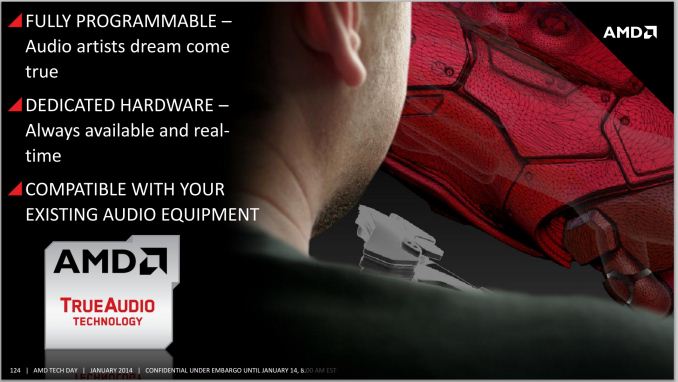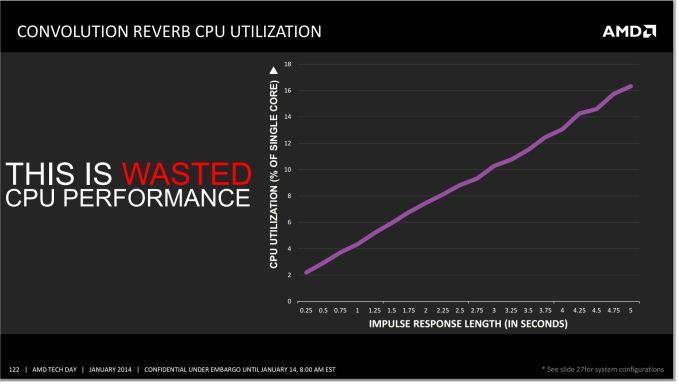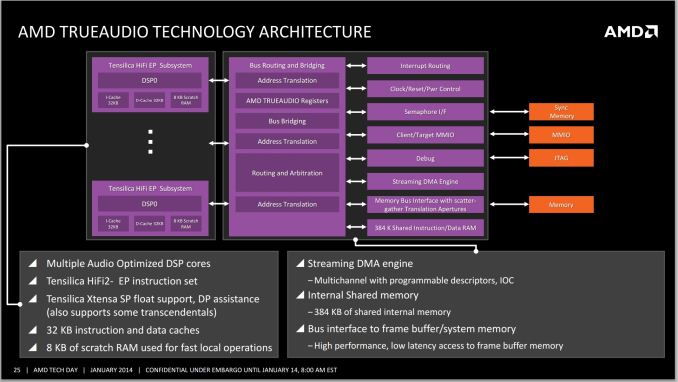AMD Kaveri Review: A8-7600 and A10-7850K Tested
by Ian Cutress & Rahul Garg on January 14, 2014 8:00 AM ESTTrueAudio
As part of the Kaveri package, AMD is also focusing on adding and updating their fixed function units / accelerators. Due to the jump on the GPU side to GCN we now have the TrueAudio DSP to allow developers to increase the audio capabilities in game, and both the Video Codec Engine (VCE) and Unified Video Decoder (UVD) have been updated.
All the major GPU manufacturers on the desktop side (AMD, NVIDIA, Intel) are pushing new technologies to help improve the experience of owning one of their products. There are clearly many ways to approach this – gaming, compute, content consumption, low power, high performance and so on. This is why we have seen feature like FreeSync, G-Sync, QuickSync, OpenCL adoption and the like become part of the fold in terms of these graphics solutions.
AMD’s new feature is TrueAudio - a fully programmable dedicated hardware element to offload audio tasks to.
The main problem with developing new tools comes down to whether they should be implemented in a general fashion or with a dedicated element. This comes down to the distinction of having a CPU or an ASIC do the work – if the type of work is specific and never changes, then an ASIC makes sense due to its small size, low power overhead and high throughput. A CPU wins out when the work is not clearly defined and it might change, so it opens up the realm of flexibility in exchange for performance per watt.
CPUs are now significantly powerful that a range of audio based techniques are available to them and the algorithms are optimized. The only limitation in this regard is the imagination of the developer or audio artist, which actually becomes part of the problem. When implementing an audio filter on the fly to a video game, the processing via the CPU can be overly taxing, especially when the effect is persistent over a long time. The example AMD gave in their press slide deck is one of adding reverb to an audio sample. The longer the reverb, the bigger the draw on CPU resources:
AMD cites this CPU usage as the effect of one filter on one audio sample. Imagine being in a firefight situation in a video game, whereby there are many people running around with multiple gunshots, splatter audio and explosions occurring. Implementing effects on all, and then transposing audio location to the position of the character is actually computationally expensive, all for the sake of realism. This is where the TrueAudio unit comes into play – the purpose is to offload all of this onto a dedicated bit of silicon that has the pathways built in for quicker calculations.
TrueAudio is also implemented on AMD's latest-generation R9 260 and R9 290 video cards – basically anything at least GCN 1.1 and up. Meanwhile we also know that the PS4’s audio DSP is based on TrueAudio, though given the insular nature of console development it's not clear whether the APIs are also the same on both platforms. AMD for their part is working with major audio middleware plugins (wwise, Bink) in order to help develop the TrueAudio ecosystem, so even in the case where the APIs are dissimilar, middleware developers can abstract that and focus on the similarities in the hardware underneath.
As is usually the case for these additional hardware features, games will need to specifically be coded to use TrueAudio, and as such the benefits of TrueAudio will be game specific. At the same time there are not any games currently on the market that can take advantage of the feature, so the hardware is arriving before there is software ready to use it. The first three games on AMD's list that will support TrueAudio are Murdered: Soul Suspect, Thief, and Lichdom. Much like FreeSync, I expect the proof is in the pudding and we will have to wait to see how it can affect the immersion factor of these titles.
Unified Video Decoder and Video Codec Engine
I wanted to include some talk about the UVD and VCE with Kaveri as both are updated – we get UVD 4, an update to error resiliency for H.264, and VCE 2, as shown below:
Of the two blocks, the improved VCE has the more interesting improvements to discuss. With the addition of support for B frames in H.264 encoding, the resulting ability to do backwards frame prediction should help improve the resulting image quality from VCE and/or reduce the required bitrates for any given quality level. Meanwhile the addition of support for the higher quality YUV444 color space in the H.264 encoder should help with the compression of primarily linear lineart/text, which in turn is important for the clarity of wireless displays.





















380 Comments
View All Comments
jasonelmore - Tuesday, January 14, 2014 - link
I really wish these were launching in BGA GDDR5 Laptop/Mini ITX Packages.jaydee - Tuesday, January 14, 2014 - link
Pretty much what I was thinking as well. There are two mini-ITX FM2+ motherboards available on newegg, niether are "thin", and neither have DisplayPort. AMD's opportunity here is to market it's 45W Kaveri as the best CPU/GPU for the price in a small package. They NEED to get outside of the typical ATX, micro-ATX, mini-ATX box and into SFF, have all the ports that everyone wants, be creative with packaging and configurations (like GDDR5). They will never win a war with Intel in the traditional form-factor PCs, which is a rapidly shrinking market anyways.takeship - Tuesday, January 14, 2014 - link
Agreed. Any build not restricted to half height GPUs is better off going with a cheap intel cpu & discrete card. AMD really should be targeting ultra SFF type builds where Iris Pro is thermally limited, and a dGPU isn't an option.rhx123 - Tuesday, January 14, 2014 - link
GDDR5 7750's are available half height and at a decent price point, so even in a Low Profile machine a cheap Intel + 7750 is a better option. That's what I'm running anyway. Passively cooled i3 never reaches above 65c and the Saphire 7750 Low Profile is pretty quiet at idle.Mopar63 - Tuesday, January 14, 2014 - link
The last paragraph of this article shows someone that GETS IT, where Kaveri and the APU design in general is heading.nissangtr786 - Tuesday, January 14, 2014 - link
I can't believe how right I was, I was saying i3 4130 cpu performance and 2400-2500 3dmark11 gpu performance similar to my gt650m in my laptop. Funnily enough my laptop with i5 3210m at 2.9ghz gt650m with screen takes 87w, if I had an i3 4130 it would take about 92w lets say so it is about right. I am more shocked how spot on I was.HammerStrike - Tuesday, January 14, 2014 - link
The entire Anand reader base congratulates you on your deep insight and prophetic powers of deduction.nathanddrews - Tuesday, January 14, 2014 - link
I, for one, welcome our new nissangtr786 overlord.Zorba - Tuesday, January 14, 2014 - link
It would have been nice to see some non-integrated chips added to the benchmarks like an FX-6300. Ever since the APUs came out, it seems no reviews actually compare high-end iGPU vs moderate dGPU and CPU. Looking at the price, you could get a decent CPU+GPU for the cost of the A10-7850K, so it would be nice to see that as an option.R3MF - Tuesday, January 14, 2014 - link
"do any AnandTech readers have an interest in an even higher end APU with substantially more graphics horsepower?"Yes, and No.
I do want a higher-end APU, but I'd like to see one with four CPU modules and 256 shaders:
47% of the kaveri die space is GPU
http://www.extremetech.com/wp-conten...d-to-intel....
If you consider that roughly 20% is uncore, that leaves roughly 33% as CPU.
Give or take, 8 shader cores is fifty percent larger than 4 cpu cores.
You could double that cpu portion to 66%, and still leave 14% for shader cores.
Make the total die size just 10% bigger and you have an 8 cpu core APU with 4 HSA enabled shader cores ready to grind through FPU work. pretty much die-size neutral.